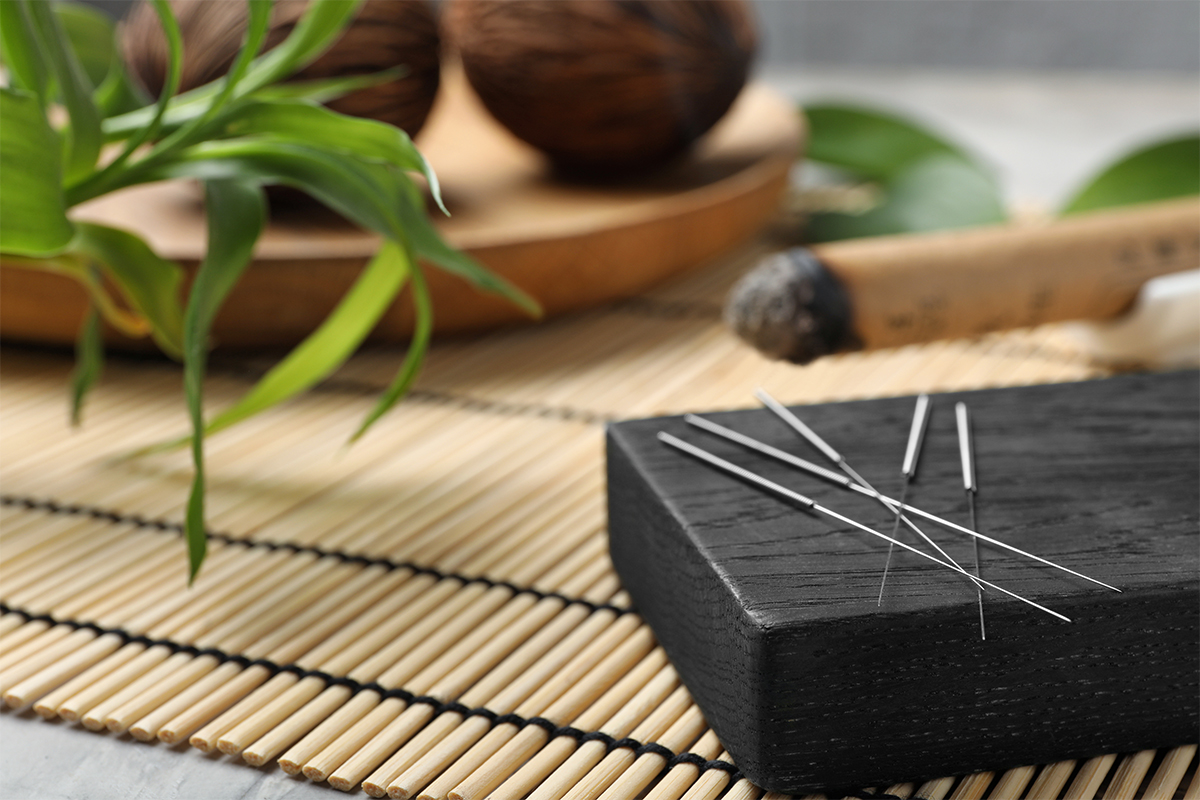
Most likely, your first exposure to acupuncture is in movies or on tv as a funny cutaway gag showing a character with lots of needles stuck in them. But acupuncture has gained recognition for providing genuine relief where other remedies might have fallen short.
What is Acupuncture?
Acupuncture is a part of Chinese traditional medicine that involves inserting thin needles into specific points on the body. This is thought to stimulate the nervous system and promote healing, pain relief and other positive health effects.
The guiding principle of acupuncture is based on the concept of qi, which is believed to be the vital energy that flows through pathways called meridians in the body. In this system, health issues are the result of qi becoming unbalanced or blocked. By stimulating the body’s specific meridians, acupuncture aims to restore the proper flow and balance of qi in the body.
Does Acupuncture Hurt?
Given the use of needles, you may be wondering if acupuncture is painful. Most people report feeling a slight prick with each insertion that is less painful than a blood draw or vaccination.
Upon insertion, a common sensation is a dull ache or tingling in the muscle into which the needle is inserted.
What Are The Benefits of Acupuncture?
There are a range of benefits that acupuncture is believed to provide. Here are some of the primary ones which have been tested.
Relief from Chronic Pain
Acupuncture has had a long history of being used to treat pain and that use holds up under more intense examination. In a study of 18,000 patients with chronic-pain patients (including low back, neck, and shoulder pain) reported that a course of acupuncture reduced pain for the next 12 months.
Relief From Migraines and Headaches
Acupuncture may also prevent and relieve the pain from migraines and headaches. The American Academy of Family Physicians states that acupuncture is 50% more effective than normal treatments at reducing headache frequency.
A 2017 placebo-controlled study in JAMA Internal Medicine followed individuals diagnosed with migraines who received acupuncture five days a week for four weeks. After the treatment, the individuals who received real acupuncture saw a greater reduction in migraines 16 weeks after starting the study than those who were given the placebo (sham acupuncture).
Control Over Nausea and Vomiting
Individuals turn to acupuncture to relieve nausea and vomiting from chemotherapy, surgery, pregnancy or motion sickness. Given the range of these conditions, acupuncture doesn’t address the conditions but seems to rather dull the nausea or vomiting response.
An abstract from the National Library of Medicine states that the mechanism by which this happens is that acupuncture, in short, causes the release of beta-endorphins and ACTH, subsequently inhibiting the CTZ and vomiting center.
Improved Sleep
Modern lifestyles present many challenges for sleeping regularly and enough. There are thousands of products on the market to address this including supplements, over-the-counter medicines and prescription medications. In China, however, acupuncture is widely used for treating insomnia and improving sleep generally.
In a 2009 review, randomized trials involving 3811 patients were evaluated and found that acupuncture had an equal effectiveness with many medications and results were even better for those who used acupuncture and medication.
Improved Quality of Life for Those with Allergic Asthma
Disclaimer: acupuncture is not alleged to cure asthma. Individuals experiencing an asthma attack absolutely should NOT use acupuncture as a substitute for immediate medical intervention.
In the case of allergic asthma, which is caused by allergens like dust, mold pollen and food, acupuncture has shown some ability to improve quality of life over time. One study found that participants who underwent 12 acupuncture sessions targeting asthma-specific pressure points over four weeks reported a greater improvement in general well-being compared with a control group who received the same number of acupuncture treatments that didn’t target these asthma-specific points.
The cause of this may be found in the participants' blood tests which showed that the acupuncture group had reductions in inflammatory cytokines after 4 weeks. Because asthma causes inflammation of the airways, there is a speculated link between acupuncture treatments, lower levels of inflammatory cytokines and improved quality of life.
Frequently Asked Questions About Acupuncture
Dry Needling vs. Acupuncture: What’s the Difference?
Dry needling and acupuncture are both practices in which thin needles are inserted into the body for therapeutic purposes. But they each have distinct principles and applications from one another.
In acupuncture, the needles are inserted into the specific acupuncture points based on TCM principles to regulate the flow of qi throughout the body. On the other hand, in dry needling, the needles are inserted into trigger points or tight muscle bands to elicit a twitch reaction from the muscle with the goal of relieving tension.
Another distinction is that acupuncture is performed by trained acupuncturists and TCM practitioners whereas dry needling is performed by physical therapists, chiropractors and medical doctors.
Are There Different Types of Acupuncture?
Yes. When we discuss acupuncture, we’re typically discussing the primary form of Traditional Chinese acupuncture. However, there are several additional types.
- Japanese acupuncture
- Korean hand acupuncture
- Auricular acupuncture
- Electroacupuncture
- Scalp acupuncture
How Does Acupuncture Work?
In traditional Chinese medicine, needles are inserted into acupuncture points along the body’s 12 main meridians to help open or balance the flow of qi.
Upon further examination in the West, it turns out, the acupuncture points are connected to the central nervous system. When these points are stimulated, chemicals are released into the muscles, spinal cord, and brain. These biochemical changes are believed to be the source of acupuncture’s health benefits that we discussed previously.
What to Expect When You Get Acupuncture
During your first acupuncture treatment, your acupuncture practitioner will tell you the general site of the planned treatment and whether you need to remove any clothing. From there, the treatment will typically go as follows.
- Needle insertion - The practitioner typically inserts 5-20 acupuncture needles to various depths at strategic points on your body (If you’re going for pain, you may notice that the insertion points may not be in the same location as the pain you’re feeling). You may feel a mild aching sensation when a needle reaches the correct depth. But most patients don’t report pain with many saying they don’t even feel the needles being inserted.
- Needle manipulation - Your practitioner may gently move or twirl the needles after placement. Alternatively, they could apply heat or mild electrical pulses to the needles.
- Needle removal - For most treatments, the needles stay in place for 10 to 15 minutes while you lie still and relax. After this point, they can be removed with little to no discomfort.
How to Find a Reputable Acupuncturist
Because the practice involves the use of needles it is important to be selective and find a reputable practitioner. If you know someone who has had a positive experience with acupuncture, one of your best options may be to ask for a referral.
If you need to look from scratch, make sure the practitioner you choose is licensed. Licensed practitioners typically have an LAc after their name indicating they’ve passed the National Certification Commission for Acupuncture and Oriental Medicine (NCCAOM) exam or completed the NCCAOM program in the foundations of Oriental medicine, acupuncture, and biomedicine. Certifications can vary by state such as California which has its own.
Bottom Line
While it’s tempting to put acupuncture in the same category as a superstition, research institutions are still finding evidence that acupuncture may provide relief for pain, migraines, nausea and sleep problems. As a result, it's gaining popularity as a remedy for individuals who have not had success with alternatives.
This article is provided for informational purposes only and is not intended to be used as medical advice. If you have immediate concerns about your health, please seek the help of your physician.
*These statements have not been evaluated by the Food and Drug Administration. Products are not intended to diagnose, treat, cure or prevent disease.




Validate your login
Sign In
Create New Account